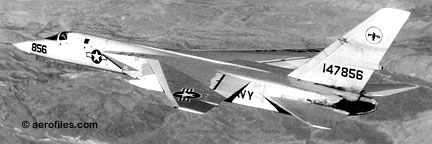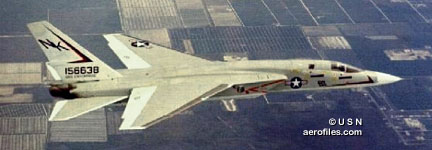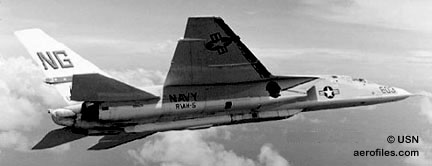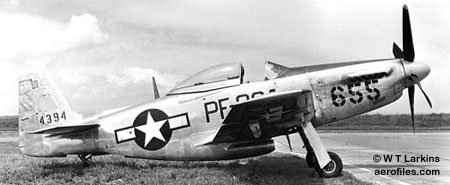Here are the aircraft I worked on at
North American Aviation, Inc.
The Vigilante was the main one, produced at the Navy plant in Columbus, Ohio. It was in the final design stage when I arrived. Our group was called Dynamics Research & Development. We were responsible for resolving all structural problems related to fluctuating loads, such as vibration and flutter, acoustics that might cause vibrations resulting in metal fatigue, maneuver loads in flight, stress reversals from landing and take-off, especially on aircraft carriers—all under various configurations of stores of fuel and munitions.
We had to cover all flight conditions involving performance up to Mach 2.0 and altitudes up to 70,000 feet (production versions reportedly achieved Mach 2.5 and altitude over 91,000 feet). At high speed the air friction caused the surfaces to heat up so much that we had to include thermal degradation of the structure, also. We used principally both active and passive element analog computers to simulate the entire range of conditions, called the flight envelope. We fed the results of the analog simulations into a digital computer to solve the Eigenvalue problem and obtain the flutter speed. We were constantly devising new and improved methods. Our results were compared to those of physical tests performed on various parts of the structure, and some on an entire airframe.
We also utilized scaled-down models of the airplane, carefully designed and built with distributed mass so that the dynamic response in a wind tunnel would be valid. Wind tunnel tests, then, were compared with our analytical results. Once we had a prototype in the air we used shaped charges (explosives) on the wings in flight to measure the damping of the induced motion. Thus, it was possible to obtain an accurate estimate of the flutter speed without having to destroy the test ship or risk the safety of the test pilot.
An unexpected and potentially dangerous incident occurred dring flight testing. A landing gear door fell off over the middle of Columbus and landed on High Street, the main drag. Fortunately there were no injuries.
One of my assignments was to build a quick and dirty cockpit simulator for the A3J. Another fellow who had airforce training and was an experienced pilot worked with me. When completed our plywood box was replete with a real A3J pilot's seat, stick and rudder pedals attached to bungee cords to create the proper resistance in the controls, and all the major flight instruments approximated with electrical meters and other electrical instruments and servo controls. All this was wired up to the analog computer which simulated the airplane and fed commands to the servos to provide the proper "feel" according to the actions of the pilot. The simulator was good for the entire flight envelope up to 70,000 feet and Mach 2.0. We had the test pilots using it and they declared that it did, indeed, realistically reproduce control responses. Following the success of our elegant plywood crate-model, the company built a Link-type trainer in our test theater. I was rewarded with a test ride in it, where I had to land on a heaving carrier deck projected on an enormous screen. I probably destroyed the "plane" but I really don't remember, except that it was fun giving it a try. The classy simulator had several degrees of freedom used to give you a bumpy ride, somethiing our little box job could not do.
A3J (A-5) Vigilante
The two aircraft that rank as the heavist the Navy ever deployed aboard carriers are the A-3 Skywarrior and the A-5 Vigilante. Designed by North American to be a supersonic, all weather, strategic bomber, the Vigilante began life as the A3J and was redesignated A-5 in the general redesignation of Defense Department airplanes that occurred in 1962. The contractor reffered to this design as the "North American General Purpose Attack Weapon" (NAGPAW).
The first contract for this aircraft was awarded to North American by the Navy on 29 August 1956. Its first flight occurred two years later on 31 August 1958. Technical difficulties and strategic priorites prevented the A3J from ever serving in its intended role, but did find a valuable place as a reconnaissance aircraft. The Vigilante was first reported in squadron by VAH-3 in June 1961, and completed it final deployment in September 1979. A total of 156 Vigilantes were bought.
The “Vigilante” original design and purpose was as a long-range nuclear delivery platform operated from aircraft carriers. This plane had a mach two—twice the speed of sound—capability. The weapon was carried internally in a “linear” bomb bay between the two engines, and it was ejected rearward. Extra fuel tanks were also carried in the bomb bay.
When the reconnaissance Vigilante was produced with many recon packages both external and in the bomb bay, the speed was limited to just over the speed of sound. Some of the recon packages included many camera types and flasher pods for night photo work. There was also an in-flight refueling system that could be carried in the bomb bay.
Specifications
| Schematic |  Click to enlarge Click to enlarge |
| Propulsion: |
Two 17000 lbs General Electric J79-8 or two 15,690 lbs General Electric J79-2 |
| Crew: | Two |
| Height: Tail Upright Tail Folded |
19 ft 14 ft 6 in |
| Length | 76 ft. 6 in. |
| Span: Open Folded |
53 ft. 42 ft. |
| Wing Area | 700 sq. ft. |
| Weight: Empty Combat |
32,714 lbs 47,530 lbs |
| Combat Range: | 1,750 nm to 2,270 nm |
| Ordnance: |
Internal stores including special weapons. Two wing stations for external stores. |
References
-
Aircraft Data—Technical Information and Drawings
Dr. William J. Armstrong, Naval Air Systems Command 1995 - A-5 Vigilante - Wikipedia, the free encyclopedia
- North American Aviation A3J-3P (RA-5C) Vigilante
- North American A3J-A5 Vigilante
- North American A-5 Vigilante - en
- A5 Vigilante photo
A5AX, A5A, A5C, RA5C Vigilante




T2J Buckeye trainer

T2J-1 (NA-253, -266) 1959 = Specs same as YT2J-1. POP: 211 [145996/146015, 147430/147530, 148150/148239]. Became T-2A.
P-51H Mustang
 P-51H, F-51H (NA-126) 1945 = 2220hp Packard Merlin V-1650-9; length: 33'4" v: 487/380/95 range: 850 ceiling: 41,600'. Designed specifically for Pacific theater; "Zero rail" rockets, six guns, 1000# bomb load. POP: 555 [44-64160/64714], of which 1 to RAF, and 1 to USN [44-64192=109064]. Redesignated as F-51H in 1948.
P-51H, F-51H (NA-126) 1945 = 2220hp Packard Merlin V-1650-9; length: 33'4" v: 487/380/95 range: 850 ceiling: 41,600'. Designed specifically for Pacific theater; "Zero rail" rockets, six guns, 1000# bomb load. POP: 555 [44-64160/64714], of which 1 to RAF, and 1 to USN [44-64192=109064]. Redesignated as F-51H in 1948.